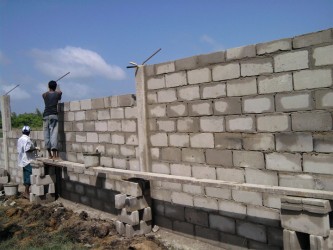As construction of the $7M fence for the Humanitarian Mission Village gets underway at Ankerville, Port Mourant, Corentyne, vulnerable persons can now be assured that help is on the way.
A project by the New Jersey Arya Samaj/Guyana Central Arya Samaj Humanitarian Mission, the village would cater for those at risk, including school dropouts, single parents, victims of domestic abuse and senior citizens.

The block-laying ceremony for the fence to launch Phase I of the Project was held in December 2012. The fence would be fitted with wire protection at the top. It will measure 348 ft by 93 ft and would be eight ft in height.
The construction of the fence on the three-quarter plot of land acquired from government, began less than one year after the sod-turning ceremony was held. It was attended by members of the diplomatic corps, donors, well-wishers and businesspersons.
On the topic of abuse, pandit Kamal Dhanesar, project advisor told Stabroek News that “it was recognized that removing the trauma from the abused is not all but removing the habit from the abuser is more important.”
He said the organization already has three social workers who would come on board to volunteer their services. Members have “realized that counseling has to be done in the family structure because that is the only way to stop the abuse.”
He said the NJAS/GCASHM is “very concerned about domestic violence and child abuse, child labour, old folks who have been abandoned, homeless persons and school dropouts.”
He said too that the village would help to “transform the society and remove poverty” by providing jobs for persons in the community.
Dhanesar who is also an executive member, pointed out that the organization is trying to provide solutions for problems that are “not one person’s problem but there are issues that override the whole Guyanese society.”
“Therefore,” he lamented, “to overcome the issues, we are working toward partnering with other NGOs, government agencies and international bodies that are willing to positively come on board.”
Dhanesar had said that there is no such facility in East Berbice and that the NGO thought it best to “create a building that would be able to serve the underprivileged.”
Phase II involves the construction of the $25M two-storey 60 ft by 40 ft building that is expected to commence next month.
Dhanesar related that in the “heart of the village there would be an empowerment centre” which would teach a variety of skills, so when the temporary residents leave they would be able to have a better life.
He also hopes that the facility would have accreditation from the Ministry of Education. The upper flat would be equipped to offer training in information technology, garment construction, and home economics.
Training in basic motor vehicle repairs and fabrication, domestic electrical installation and a small information technology lab for children with mobility difficulties would be provided in the lower flat.
The third phase of the project is a U-shaped two-flat building which would house the dormitories for 150 children, seniors, and abused victims.
It will also cater for an administrative office, nurses’ quarters and centre, quarters for house mother/father, four counselling rooms, library and sick-bay.
There would also be a multi-cultural shed where persons can practice their respective religions, a quarter for off-duty nurses and accommodations for overseas funding agents and agencies.
According to Dhanesar, services at the benevolent home would not be restricted to the persons staying-in but it would also benefit residents in the community.
Acquire a skill
He told Stabroek News that “at the initial stage children would be taken in from the age of eight.
They would remain [at the facility] until they can acquire a skill and we would ensure that they are attached to a place of employment…”
While the stay of the old folks would be on a long-term basis, the victims of the gender-based violence can choose to move on to a single life or return to a family life.
Dhanesar, also a retired school administrator, said the facility would be willing to “keep them long enough for them to acquire a skill and for them to be less traumatized so that they can move back to mainstream society.”
He mentioned that members had also applied for one acre of land to set up an agricultural plot and dairy farm in the humanitarian village so it can be sustainable and self-sufficient.
He said since that amount was not granted they are thinking of applying for another plot to set up the economic venture.
Funding
Dhanesar said the village would be powered by solar and wind power so as to reduce cost.
Funding for the project is being provided by persons living overseas while financial contributions are also obtained from local residents.
He related too that the organization had conducted fund-raising activities, including a buy-a-block sale where tickets worth $100 and equivalent to one block, were sold.
The organization has been around for several years with a mission of helping to providing better living conditions for the disadvantaged.
It started out by distributing items to the needy but has decided to move away from that because of reports that persons were selling the items.
Dhanesar said they would continue to provide food vouchers and medical assistance for deserving persons.
He told this newspaper that the organization will continue to employ skilled and unskilled labour from the locality as a way of contributing towards the social and economic development.
The advisor pointed out that the “construction of these buildings is merely the beginning of a long haul. The more demanding aspect of this project is sustainability.”
Members are hoping for continued assistance from individuals, groups, organisations both locally and overseas.
“At the same time,” he said, “leaders intend to establish a cottage industry whereby persons empowered by the Empowerment Centre can be meaningfully employed to make available products at least for the local market.”









